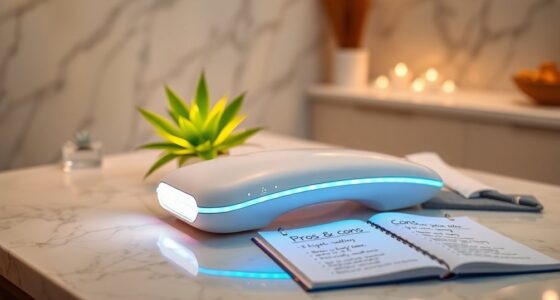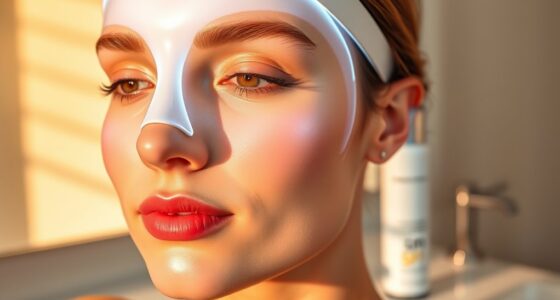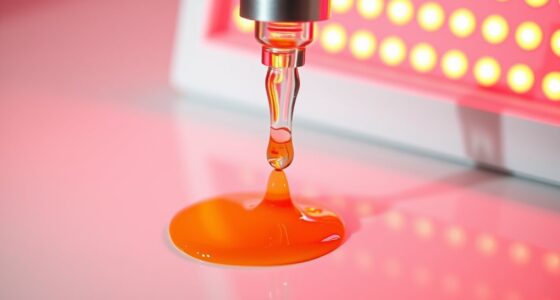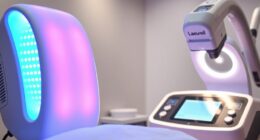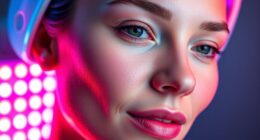Many myths surround LED lights, but facts show they’re energy-efficient, last longer, and come in various colors to suit your needs. While some worry about upfront costs or flickering, choosing reputable brands helps avoid issues. Concerns over environmental impact are valid, but LEDs are greener than traditional bulbs when properly disposed of. To truly understand LED performance and sustainability, it’s helpful to explore the scientific and safety considerations behind this evolving technology.
Key Takeaways
- Modern LEDs offer warm, inviting light options, dispelling the myth of sterile, unappealing lighting.
- LED costs are decreasing, and their energy efficiency outweighs higher upfront expenses.
- Proper selection and reputable brands ensure LEDs avoid flickering and uneven light issues.
- Environmental concerns exist due to manufacturing and disposal, requiring careful handling and recycling.
- Understanding Kelvin ratings helps choose LEDs suited to personal preferences and specific environments.

Have you ever wondered if LED lights truly live up to their reputation? It’s a common question, especially as more people switch from traditional bulbs to LEDs, expecting better efficiency and longevity. But with all the hype surrounding LED technology, it’s easy to get caught up in misconceptions. The truth is, while LEDs are impressive, they’re not perfect, and understanding the science behind them helps you make smarter choices.
First, many believe that LED lights are completely free of drawbacks. That’s not entirely accurate. LEDs do consume less energy and last longer than incandescent or fluorescent bulbs, which makes them a smart choice for most applications. However, they can be more expensive upfront, and their performance can vary depending on quality and design. Cheaper LEDs might flicker or produce uneven light, which can cause discomfort or eye strain. So, it’s essential to choose reputable brands and check for proper specifications.
Another myth is that LED lights emit harsh, cold light unsuitable for home use. While early models often had a bluish tint that some found unappealing, modern LEDs come in a wide range of color temperatures. You can now find warm white LEDs that mimic the cozy glow of traditional bulbs, making them suitable for living spaces, bedrooms, and even restaurants. The key is understanding the Kelvin rating—lower numbers (around 2700K to 3000K) provide warmer tones, while higher ones (above 5000K) produce cooler, daylight-like illumination. This means you can tailor your lighting to fit your preferences, debunking the myth that LEDs only produce sterile, uninviting light.
Many also assume that LED lights are environmentally friendly in every aspect. While they do reduce energy consumption and last longer, which cuts down on waste and power use, the manufacturing process involves rare earth metals and other materials that can be problematic if not properly recycled. Proper disposal is vital to minimize environmental impact. Additionally, some LEDs contain small amounts of hazardous substances like lead or arsenic, so handling and disposal require care. The bottom line is, LEDs are greener than traditional bulbs, but they aren’t entirely free of environmental concerns. Recent research emphasizes the importance of robust safety measures in LED manufacturing and disposal to mitigate these issues.
Frequently Asked Questions
Are LED Lights Safer for Children’s Eyes Than Traditional Bulbs?
Yes, LED lights are generally safer for children’s eyes than traditional bulbs. They emit less UV and infrared radiation, reducing potential eye strain or damage. Plus, LEDs produce less flicker, which can cause discomfort or headaches. However, it’s important to select high-quality LEDs with appropriate brightness and avoid direct, prolonged exposure to bright lights. Always supervise children around any lighting to ensure safety and comfort.
Do LED Lights Really Cause More Blue Light Exposure Than Other Lighting?
Yes, LED lights emit more blue light than traditional incandescent bulbs, which can impact your eyes and sleep patterns. Imagine a bright, icy blue glow filling your room, subtly affecting your circadian rhythm. While LEDs are energy-efficient, their higher blue light levels mean you should limit exposure, especially before bedtime. Using warm-colored LEDs or filters can help reduce blue light and protect your eyes over time.
Can Switching to LEDS Significantly Reduce Household Energy Bills?
Switching to LEDs can considerably reduce your household energy bills. LEDs use about 75% less energy than incandescent bulbs and last much longer, so you save on both electricity and replacement costs. By replacing traditional bulbs with energy-efficient LEDs, you’ll notice lower monthly bills and less frequent bulb changes. Plus, LEDs produce less heat, making your home more comfortable and further reducing cooling costs during warmer months.
Are LED Bulbs More Environmentally Friendly Than Incandescent or CFL Bulbs?
You’ll find that LED bulbs are more environmentally friendly than incandescent or CFL bulbs. Coincidentally, they use markedly less energy, which cuts down on greenhouse gas emissions. Plus, LEDs last much longer, reducing waste and the frequency of replacements. Their production also has a smaller environmental footprint. So, switching to LEDs not only benefits your energy bills but also helps protect the planet through lower resource consumption.
Do LED Lights Emit Any Harmful Radiation or Pollutants During Use?
No, LED lights don’t emit harmful radiation or pollutants during use. They produce light through a process called electroluminescence, which doesn’t release dangerous chemicals or radiation. Unlike some older bulbs, LEDs don’t contain mercury or produce UV radiation that can harm your skin or eyes. You can use LED lights safely in your home, knowing they’re energy-efficient and don’t pose health risks during normal operation.
Conclusion
You now know that LEDs are more energy-efficient and longer-lasting than traditional bulbs, saving you money and reducing waste. Did you know LEDs can last up to 25 times longer than incandescent bulbs? That means fewer replacements and less environmental harm. Don’t fall for common myths—trust the facts and make smarter lighting choices. LEDs truly are a sustainable, cost-effective solution that brightens your life without the hype.


